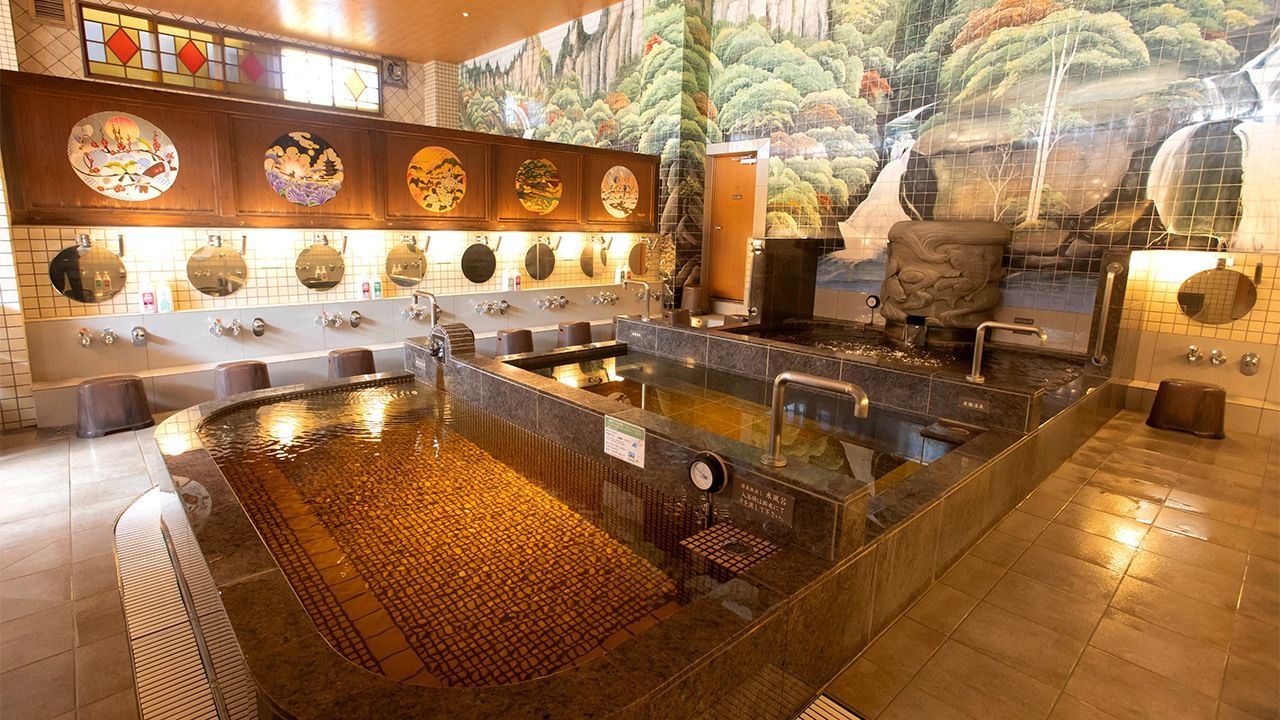
A Taste of Tokyo Bathing Culture Near Haneda Airport
Travel Culture- English
- 日本語
- 简体字
- 繁體字
- Français
- Español
- العربية
- Русский
Ōta: Tokyo’s Hot Spring Town
The area called Haneda, where the airport of that name now stands, began as a land reclamation project kicked off by a person named Suzuki Yagoemon in the eighteenth century. He built levees around the tidal flats at the mouth of the Tama River to create farmland. The project was completed in the early nineteenth century, in the time of Shōgun Tokugawa Ienari, and Haneda was born as a farming village.
The levees, though, needed regular repairs due to the waves of Tokyo Bay, and eventually suffered from a major breach. The villagers built a small hokora, or an informal shrine, to invite divine protection for the levees, which eventually became Anamori Inari Jinja. The term inari originally comes from a phrase meaning “here grows rice.” The divinity of Inari, as reflected in the name which evokes the foundations of life itself, is one that exerts great power over the daily essentials: food, clothing, and shelter.
And as Haneda stands on land where the original Anamori Inari Jinja once stood, with cooperation from the current Anamora Inari Airport Branch Shrine, JAL now sells a shrine seal book—a goshuinchō, in which people can get stamps and calligraphic inscriptions from the religious sites they visit—for those praying for safety in air travel.
The Haneda district flourished as a town built around this popular shrine, but then mineral springs were discovered in 1894. It soon transformed into a resort town for bathers. Strictly speaking, this was not an onsen, or hot spring, area, but rather a kōsen featuring mineral spring water that would be heated artificially for “hot spring baths,” with the lure of benefits to beauty and health.
That original mineral spring resort town no longer exists. However, Ōta still carries that legacy with a great many bathing facilities still running.
Regions all over Japan have long had public baths open to all. These are commonly called sentō, and many of those in Ōta’s central district of Kamata offer a chance to soak in natural spring water.
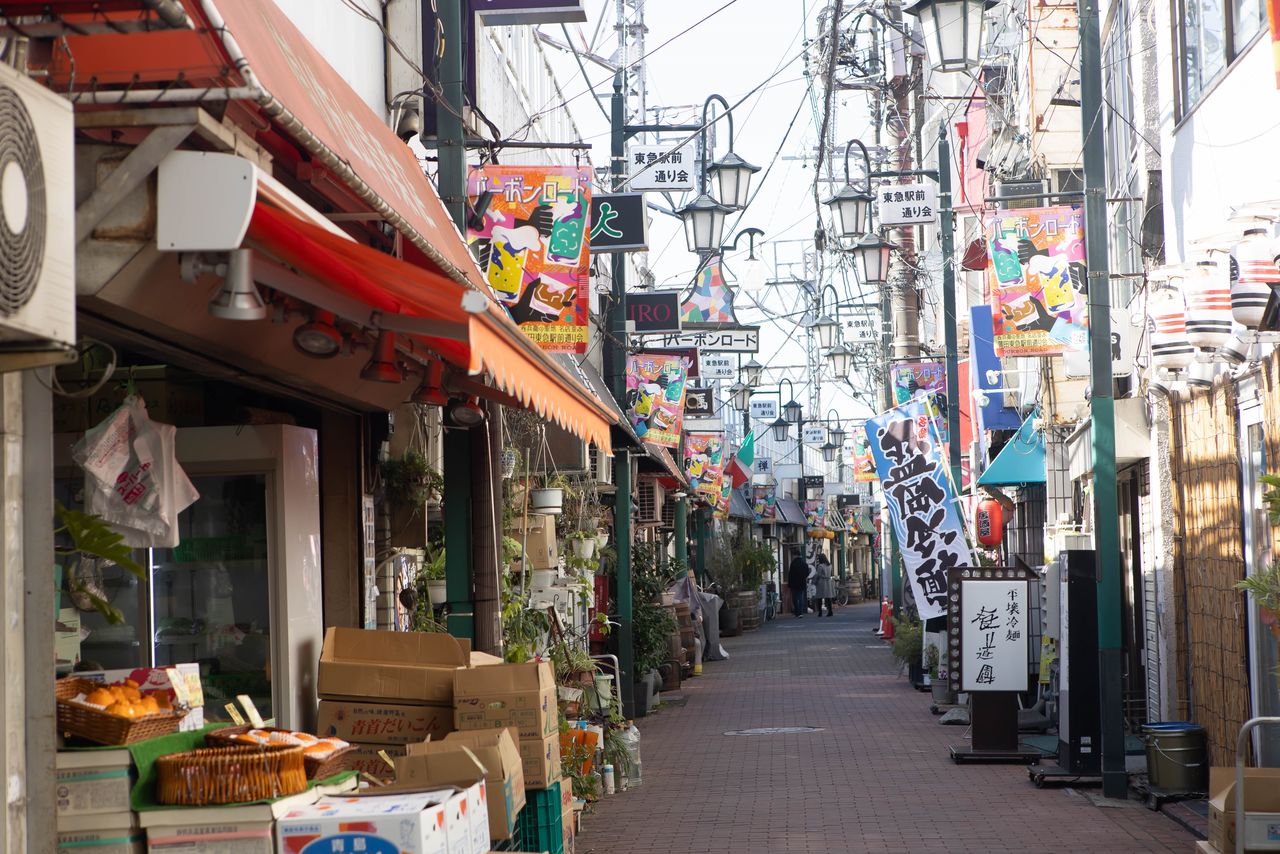
Kamata Tokkyū Ekimaedōrikai is a retro shopping street to the west of Kamata Station, nicknamed Bourbon Road. It’s lined with dining and drinking spots. (© Fukusako Ayako)
The local spring water has a uniquely dark color, earning it the nickname , or “black water.” It has rare quality imparted by ancient plant matter, and there are people who travel here from far and wide just to soak in it. From personal experience, kuroyu does seem to have outstanding effects on both beauty and health, so Ōta truly is special as Tokyo’s “onsen town.”
Every sentō will have its own charms, like huge baths or saunas, but this article will focus on three hot spring sentō with easy access from Haneda airport.
Kamata’s Retro Ambience
Ten minutes from Haneda Airport on the Keikyū line, then 10 minutes’ walk from either Keikyū Kamata Station or JR Kamata Station, will get you to Kamata Onsen. This well-loved bathhouse is rich in retro atmosphere. The entrance is found past an old-fashioned shopping arcade, and the ticket machine is in a clean, spacious lobby.
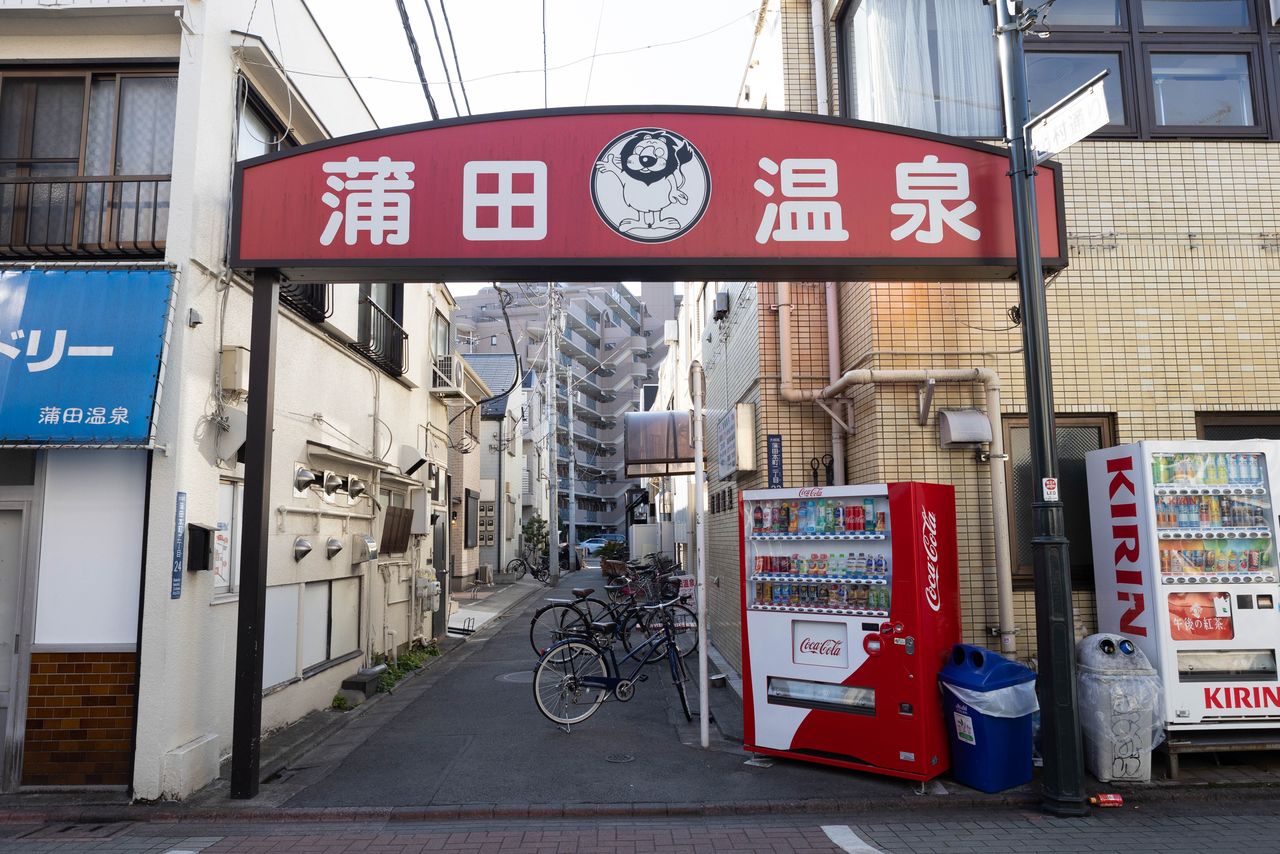
The Kamata Onsen gate appears suddenly on a residential street. (© Fukusako Ayako)
This water is a black truly worthy of note—so dark and richly colored that a dipped hand soon vanishes from view. Kamata Onsen has two baths with this black water, a cool and a hot one.
I start with the cooler one. The black water soothes my body and carries a pleasant aroma. The water is rich in sodium bicarbonate, which gives it a reputation for beautification as it smooths the skin.
I personally am more of an “endurance bather,” so I hop into the hot bath. It certainly lives up to its billing, feeling like it’s around 44 or 45 degrees Celsius. Those unused to such warmth might find it too much, so take care. However, once you’re used to such heat, it can be habit forming. I recommend those who think they can handle it to give it a try. The translucent shirayu–or “white water”—also includes minerals in the tub itself, so it feels soft on the skin.
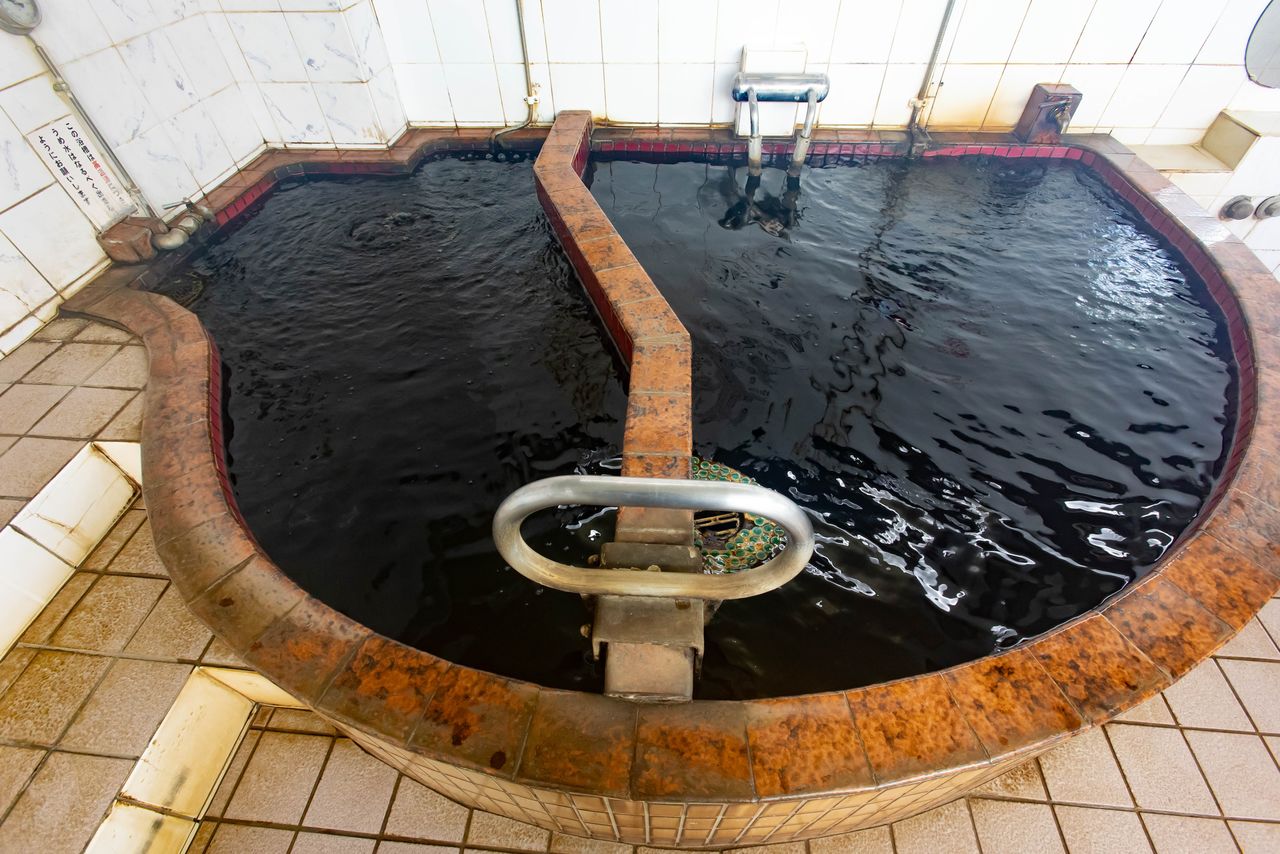
The black waters of Kamata Onsen. (© Fukusako Ayako)
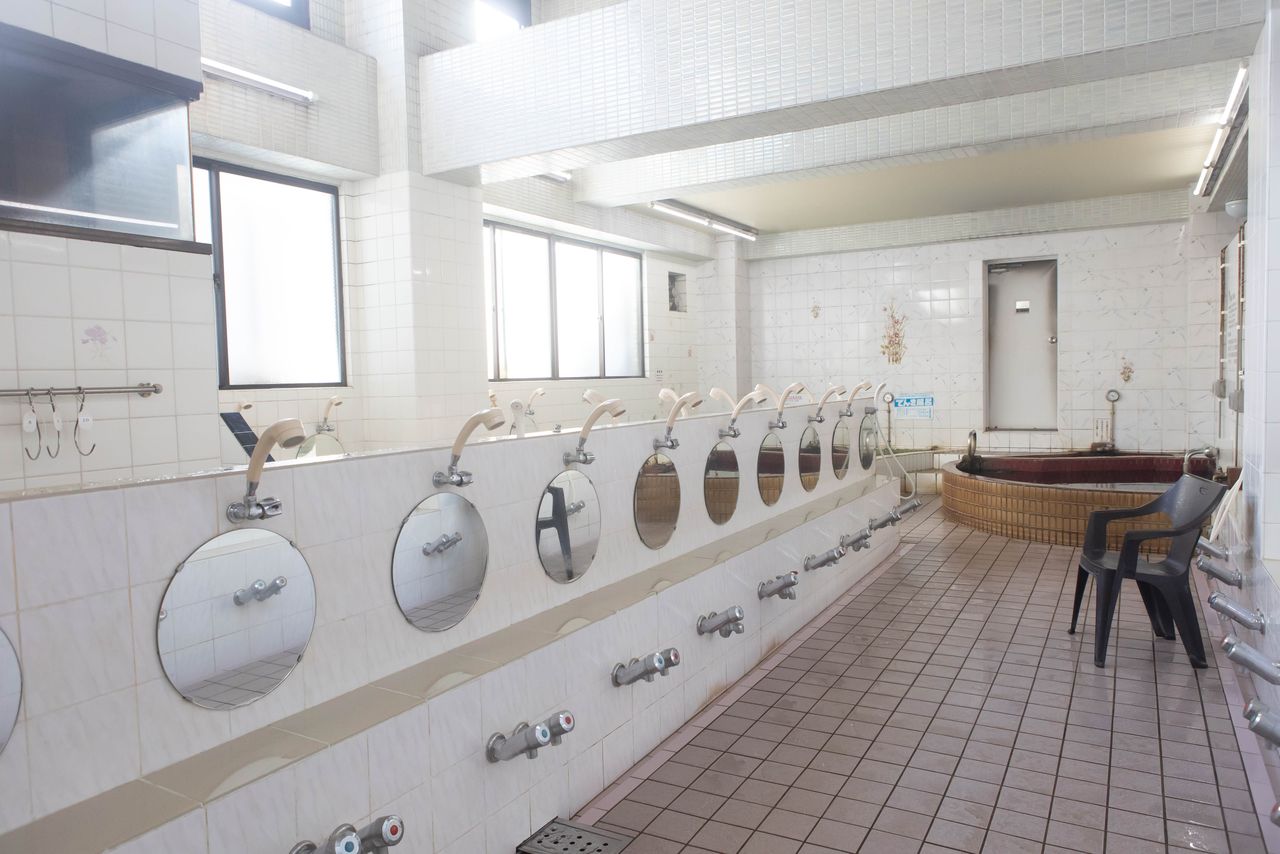
The washing area has high ceilings, and the white walls add to the open feeling. (© Fukusako Ayako)
Kamata Onsen has a large space on the second floor serving food and drink. Their famous kamameshi rice pot is highly recommended. They use only koshihikari rice and prepare it perfectly. It feels so lovely to sit in the open space and relax over a meal and some beer that you might just forget how much time has passed.
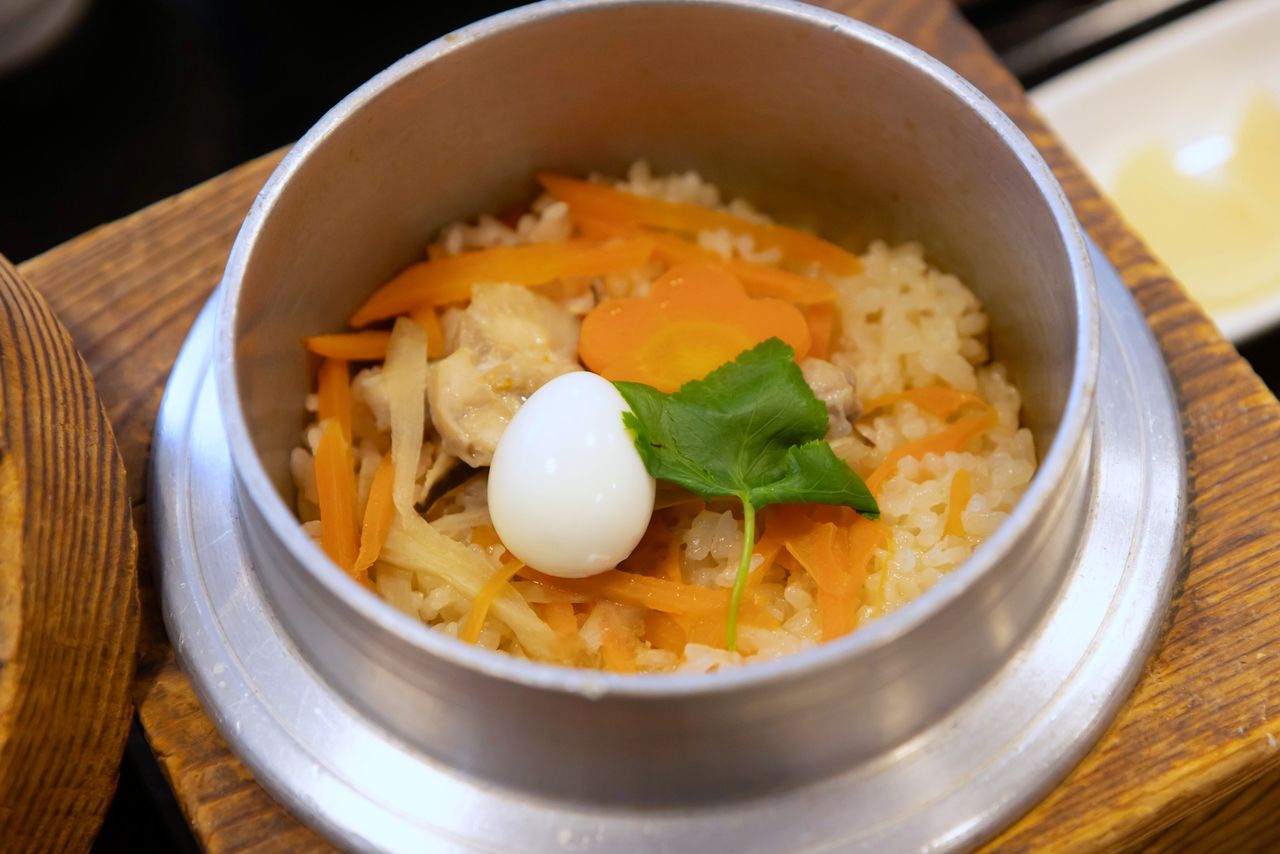
The specialty Onsen Kamameshi rice pot. With miso soup, a side dish, and pickles, ¥1,200 (tax included, as of February 2024). (© Fukusako Ayako)
Hasunuma Onsen is near Keikyū Hasunuma station. It is also within walking distance of JR Kamata Station through the shopping arcade. It has a modern design with a pleasant exterior, while inside, the baths are decorated with stained glass. The whole space is filled with soft light.
There are three baths lined up. The farthest to the back is filled with natural hot spring water. The water is a lovely olive color, with a comfortable temperature. The middle bath uses hot spring water with added gas for a sparkling experience. The carbon dioxide in the water seeps through the skin and is believed to improve blood flow. When I try the lukewarm water, the parts of my body below the water line turn warm and pink, showing the effects.
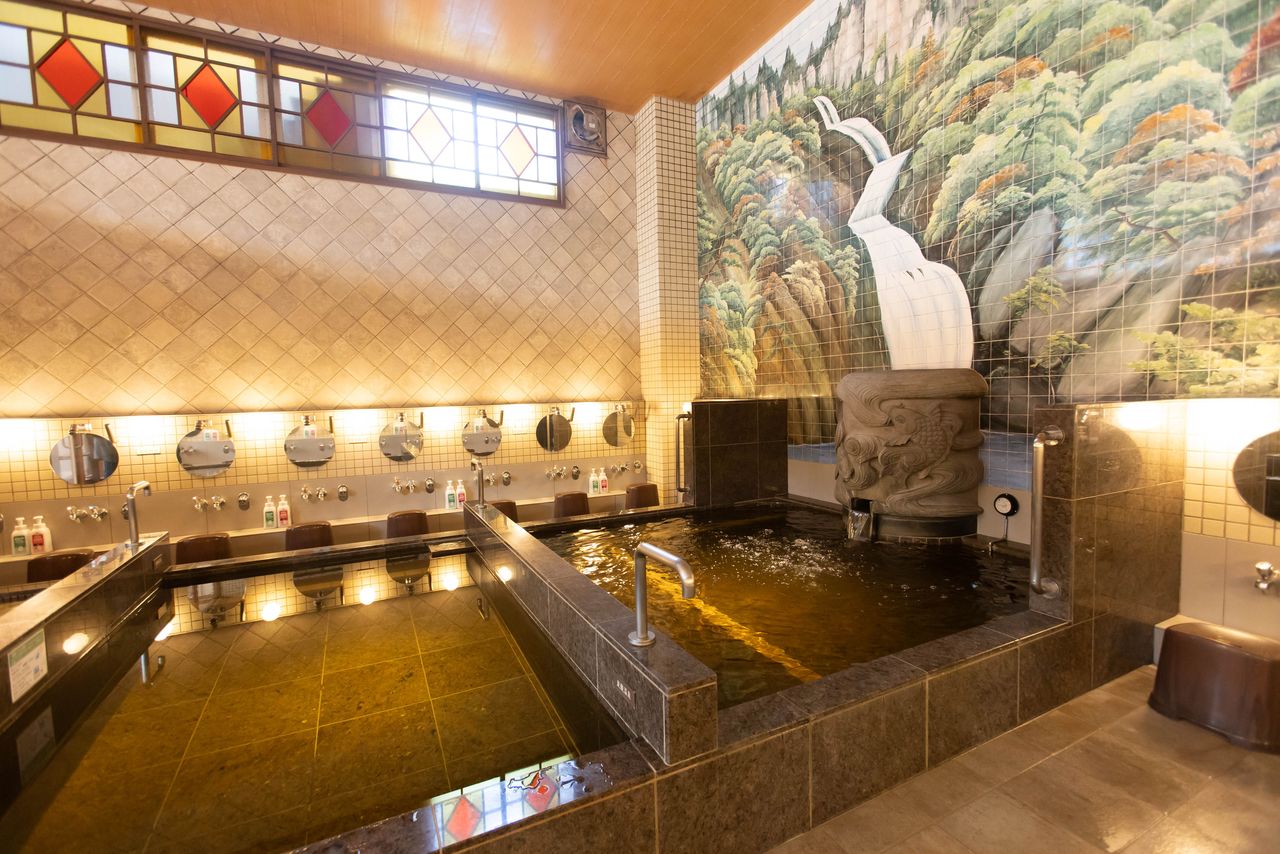
The bath spaces are decorated with modern designs like stained glass. (© Fukusako Ayako)
The third bath is a cold spring bath. This one luxuriously uses pure spring water piped directly up from the underground source. This means you can experience kakenagashi, where clean, pure spring water is piped in without recirculation or other treatment, at a sentō in Tokyo.
Soaking in the baths in order from back to front, finishing in the rare pure spring bath, is a fantastic bathing experience, to say the least. The whole thing feels like a trip to some famous hot spring resort in the mountains. After my bath, my whole body feels smooth and supple.
The owner, Kondō Yoshimasa, says overseas visitors also enjoy the baths, and on their way out offer comments like “Amazing!” and “I love it!” For me, as well, this was an amazing experience.
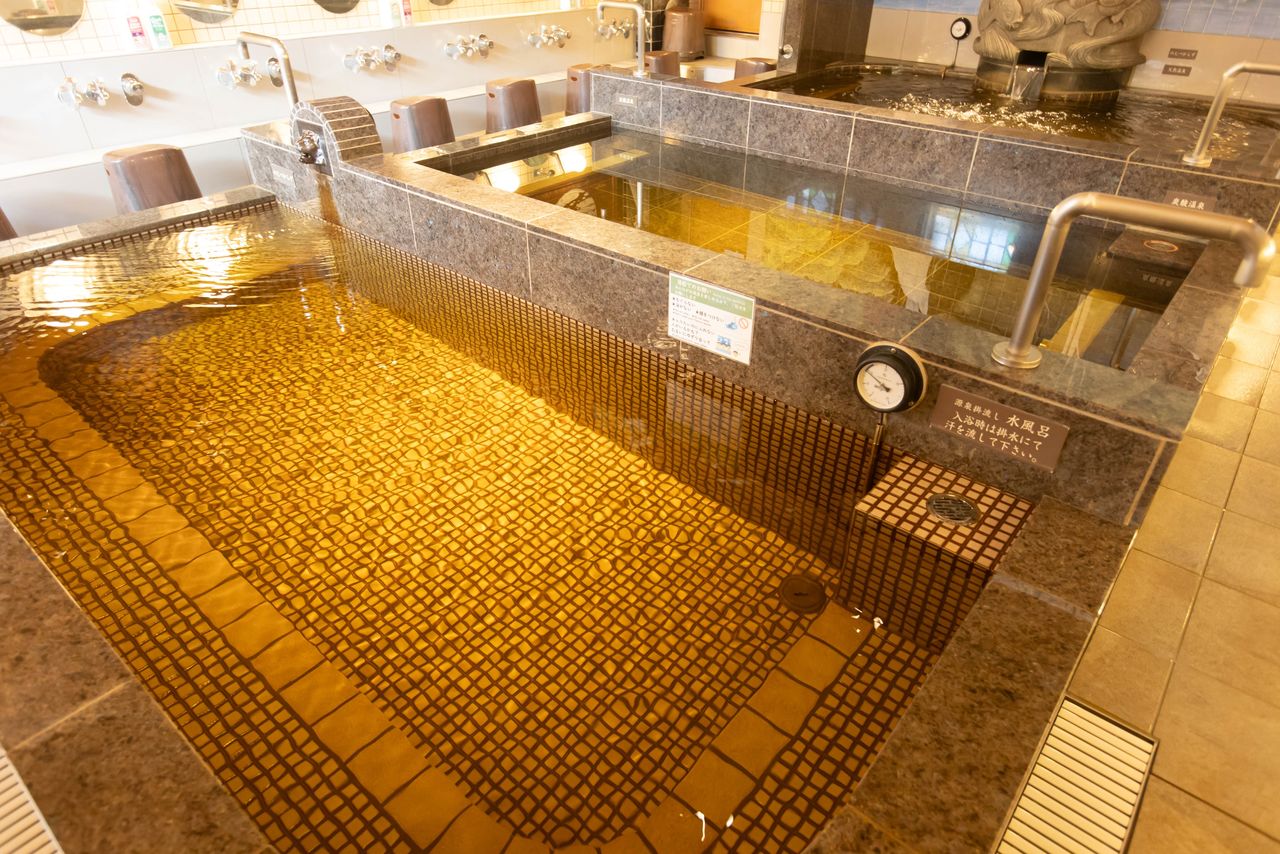
The nearest bath is a priceless fresh-flowing kakenagashi spring bath. (© Fukusako Ayako)
Walking northeast from JR Kamata Station takes you to the Nomikawa River. Cross over the bridge there and you will see a bright red neon character, ゆ, yu—meaning simply “hot water.” That is the sign for the sentō Youcity Kamata.
The great pleasure of Youcity is the outdoor bath where you can enjoy the fresh open air while soaking in the local kuroyu. Of course, it is in the middle of the city, but have no worries: there are panels to block prying eyes. The tub is still in the open air, though, outside of the bathing room, and offers a proper outdoor feeling. The water is comfortably hot, and it felt nice to get out and cool off on the side bench after about 10 minutes of soaking.
Current owner Nakamura Kentarō was a rugby player in his student days. He remembers coming home exhausted after a hard day of practice then refreshing himself in his family’s kuroyu bath. His own experience with the positive effects gives him confidence in recommending the water to customers.
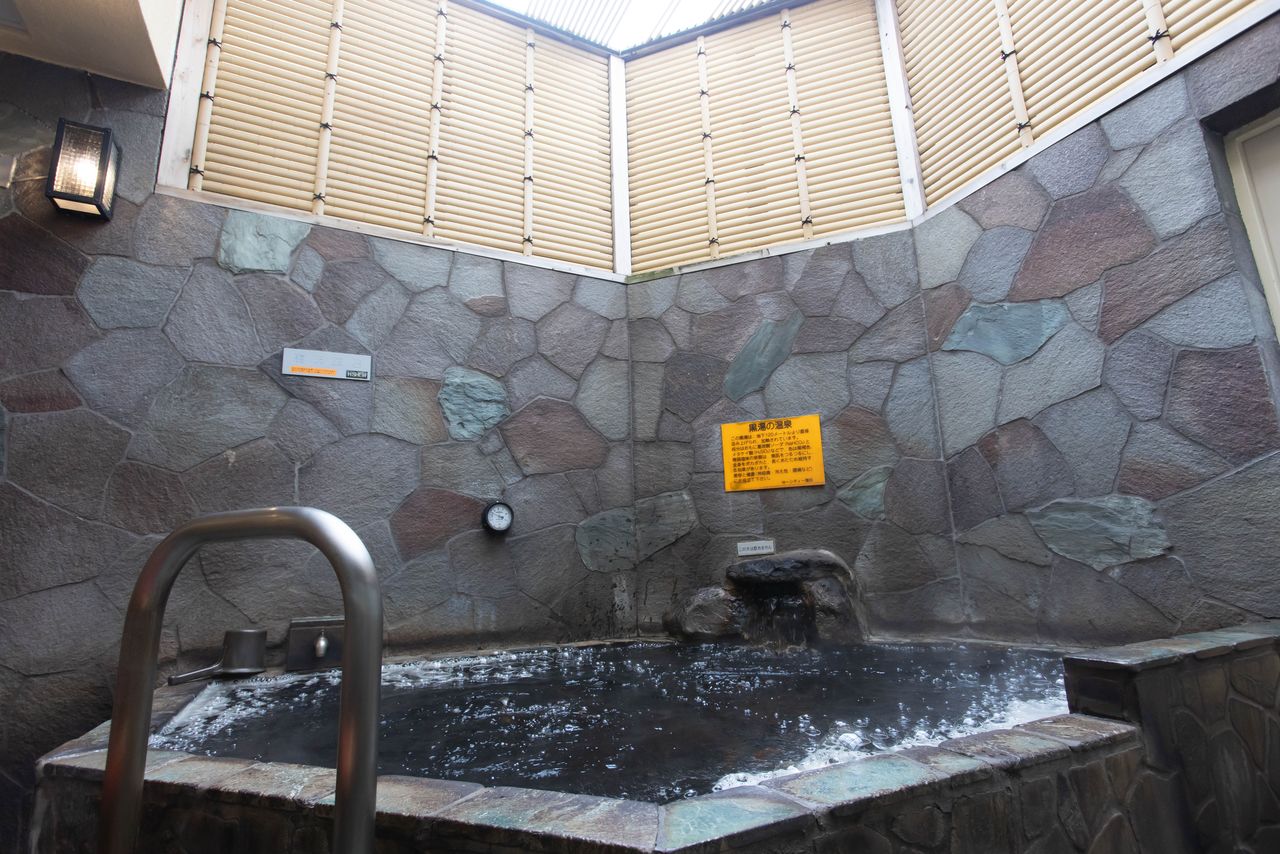
The outdoor bath is equipped with tall shades to prevent peeping, but still offers a full taste of open-air bathing. (© Fukusako Ayako)
The indoor baths are clear, and the central bathtub is equipped with a gorgeous jet bath system. To each side are a vibrabath and a mildly electrified denkiburo. A dip in these will heighten the effects of the black water and help you recover from your fatigue. I was tired out from walking over 10 kilometers that day, but these baths freshened me right up.
Travelers with big bags can leave them at the Youcity Kamata counter during their soak.
Kamata Onsen is open from 10:00 am, Youcity Kamata from 11:00 am, and Hasunuma Onsen from 2:00 pm. After arriving at Haneda Airport, you can freshen up with a soak before you check into your hotel. I also recommend dropping by on your way to the airport to bolster yourself for your flight home.
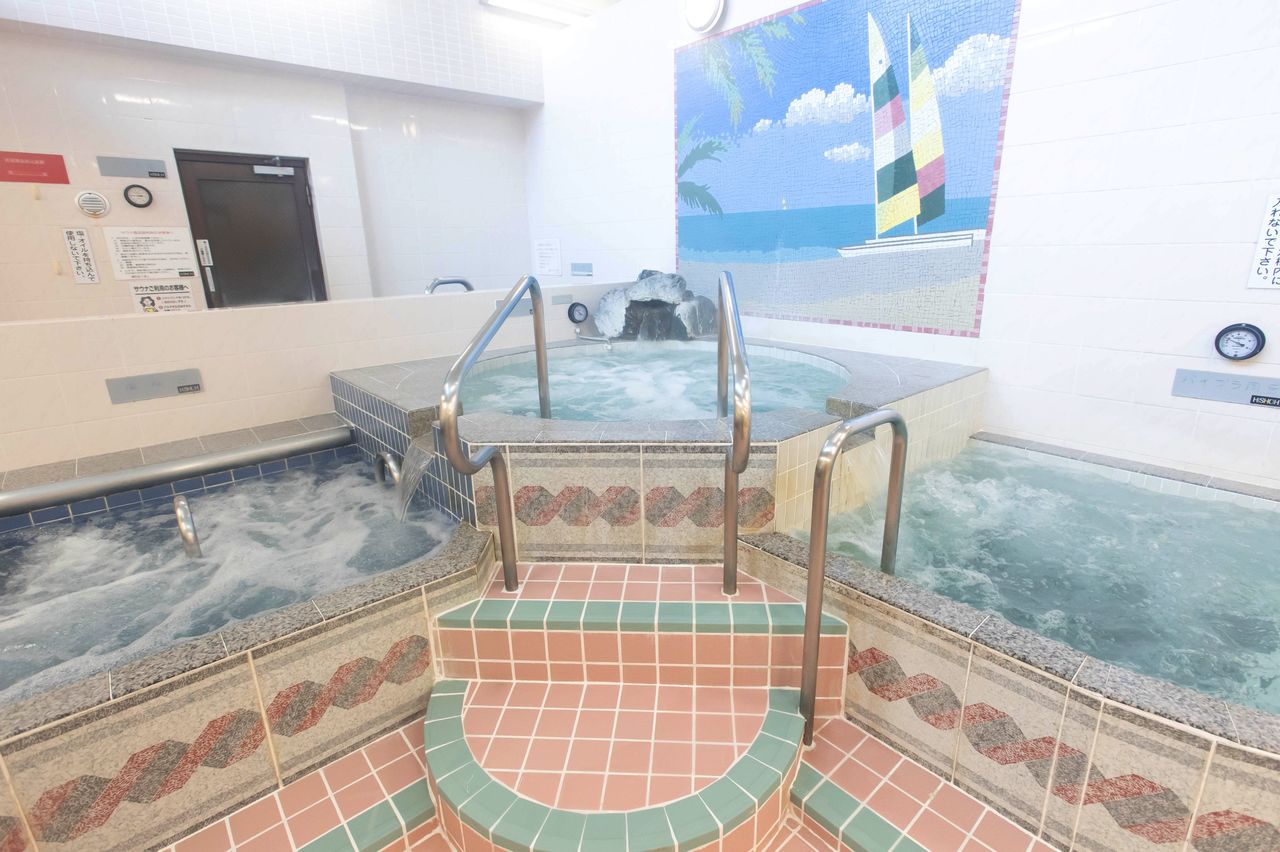
Youcity’s jet bath is in the center, with the foaming vibrabath to the left and the electrified denkiburo to the right. All can help with fatigue recovery. (© Fukusako Ayako)
About Sentō Manners
As public baths, sentō can be used by anyone. In Japan, many bathing facilities ban those who have tattoos, but sentō allow them just fine. As long as you remember a few simple manners, the doors are open.
The first of those is, no bathing suits in the sentō. Try hiding yourself with a towel if you are uncomfortable showing your front. However, Japan has an old tradition of “nude comradeship.” They say that in ancient Rome, Emperor Hadrian would visit the public baths to commune with the commoners. In Japan, the sentō is also a place where everyone is equally free to come, get naked, and enjoy the bath. You are unlikely to get comments about your body, so I recommend letting it all hang out and relaxing.
When you get into the bathing room, first wash up. This is important so as not to contaminate the bathwater. For the same reason, you are not to dip your towels in the baths. You might be thinking that your towel is fresh washed, or even new, but even brand-new towels can shed fibers into the water and contaminate it.
Also, for both men and women, the rule is that long hair must be bound up and kept out of the baths. Please be careful to ensure that your hair doesn’t come undone and fall into the water.
Those are just about all the rules to remember. After that, just enjoy some naked comradeship with friends, relax with some meditation, or whatever you want. Finally, when you leave, wipe yourself down and make sure not to get the dressing room floor wet.
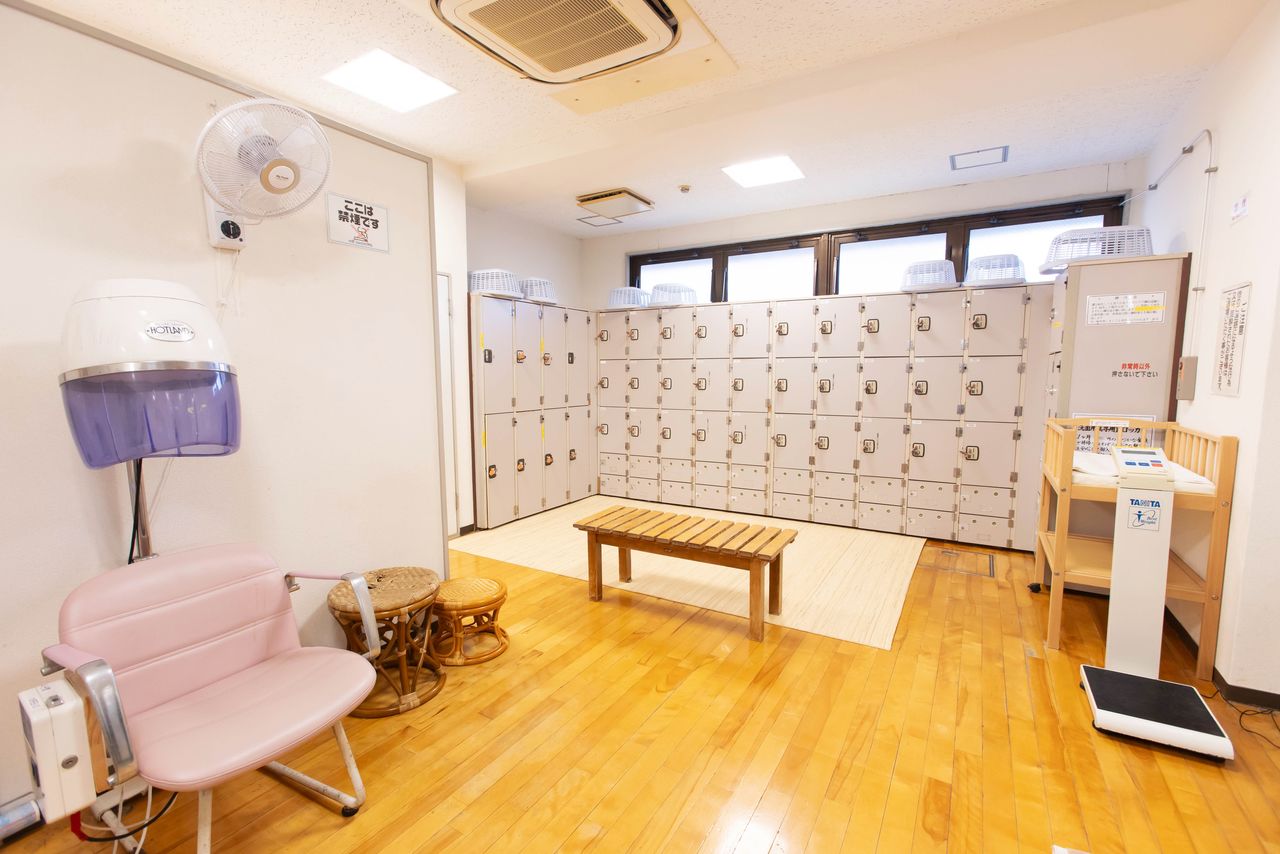
The Youcity Kamata dressing room. Please mind your manners so all may enjoy! (© Fukusako Ayako)
This article has focused on sentō using natural spring water, but of course, that isn’t the only charm of these baths. Ōta earned its name as a sentō town with a variety of lively baths, and each one has its own unique flavor.
And Tokyo as a whole has many, many more sentō with expansive spaces where you can stretch out and soothe the stress of the day. If you still haven’t enjoyed the unique charms of a sentō, I recommend first searching out one near you. For reference, in Tokyo, the cost of a sentō visit (as of March 2024, without extra charges for saunas or other features) is ¥520.
Edomae Seafood After a Soak
Ōta flourished in the mid twentieth century as a manufacturing area. It was a place where people gathered to live, not only from all over Japan, but all over the world. Kamata reflects that history with a diverse, reasonably priced food culture. One of the great appeals of the area is that you can still enjoy that culture after your bath.
The day of my visit, I visited Tempura Suzuki on the shopping street outside Kamata Station’s west exit. Tokyo Bay has long been known as a center for fresh seafood, and that seafood tradition is known as Edomae, for seafood “taken from the waters just off Edo,” a name that has developed its own brand value. As a result, seaside Ōta still has lots of seafood shops.
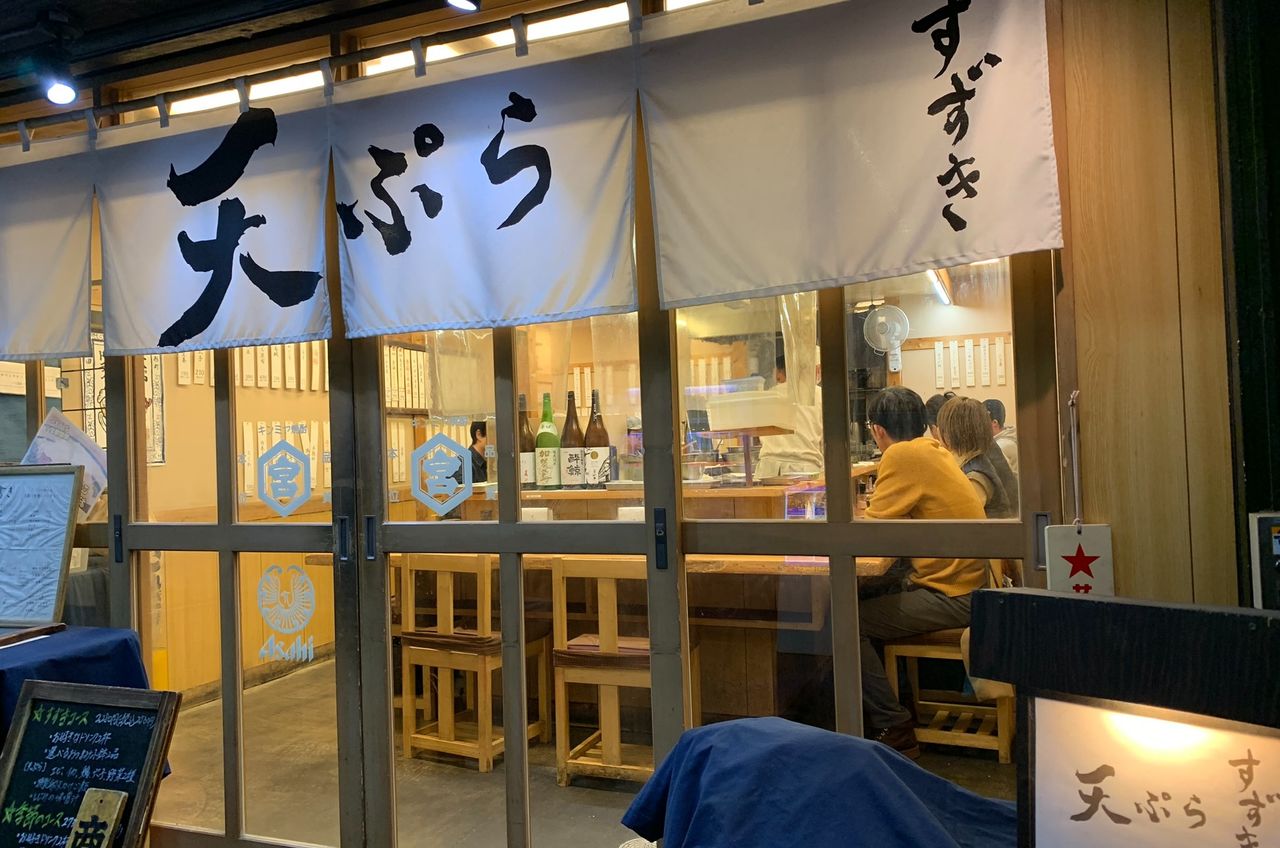
Counter-seating only Tempura Suzuki is popular with locals. (© Fukusako Ayako)
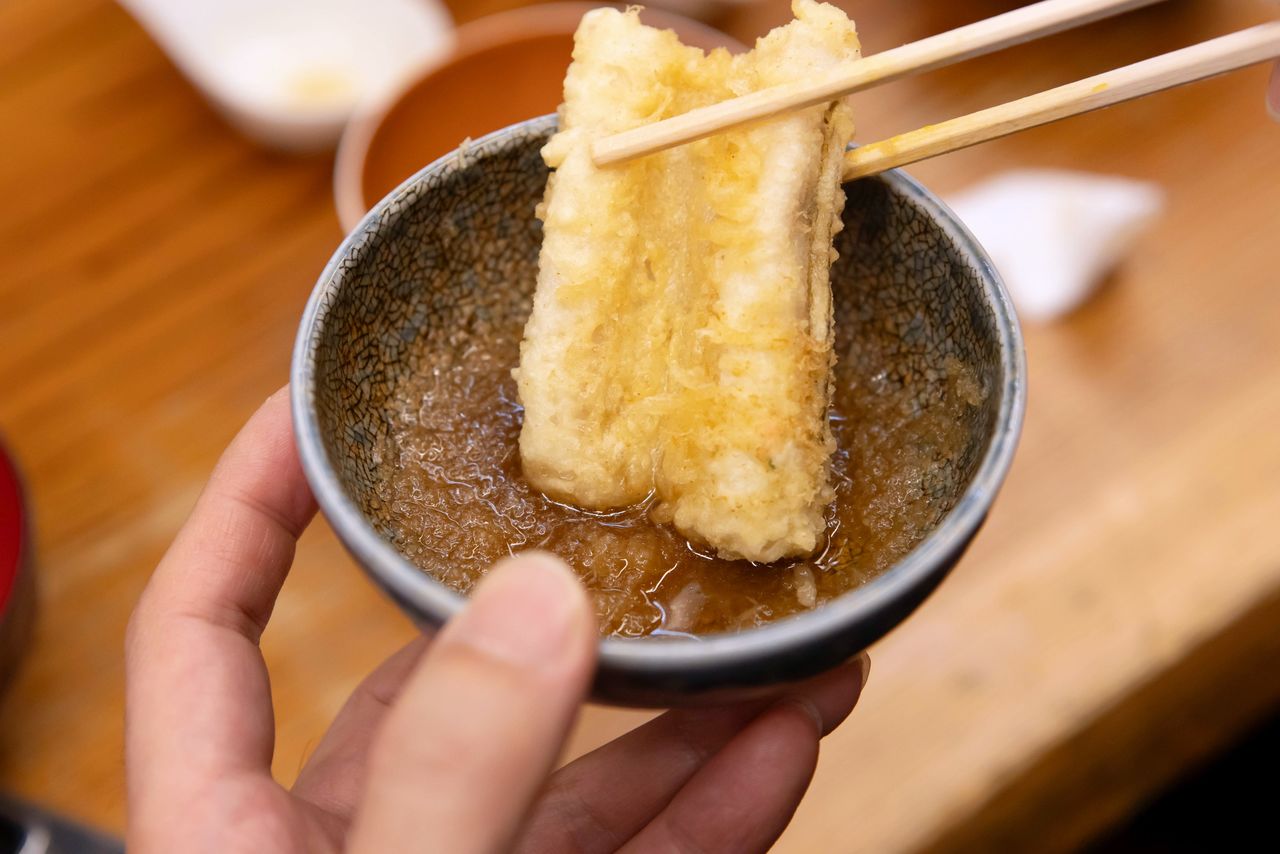
One Edomae specialty is eel tempura. Suzuki offers meal sets for lunch, and in the evening a range of reasonable tempura dishes. (© Fukusako Ayako)
At Suzuki, they serve smelt or eel tempura, and a meal set with rice and miso soup is an extremely reasonable ¥1,200 (tax included, as of February 2024). The light and airy tempura is fried in a special oil. The eel is fluffy and tender, making me feel like shouting “Kamata is the best!”
A soak in an onsen, and a delicious meal. What a day!
(Originally published in Japanese. Banner photo: Hasunuma Onsen is popular with tourists for its water quality and modern styling. © Fukusako Ayako.)